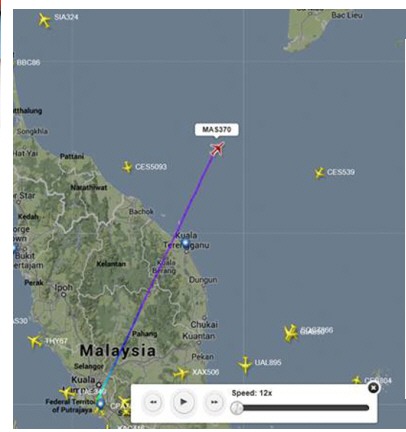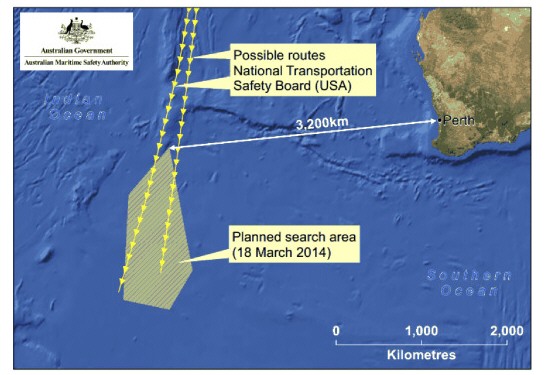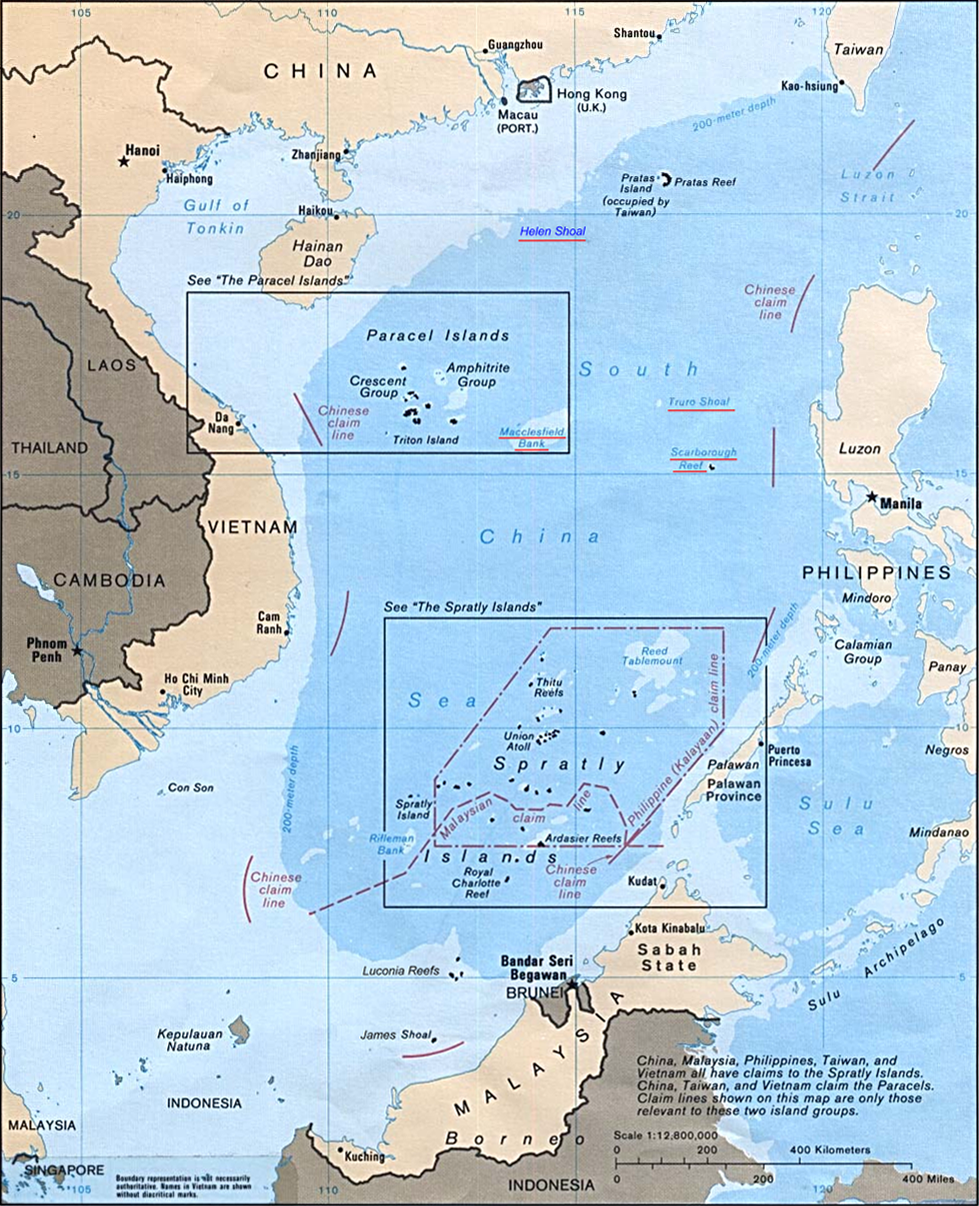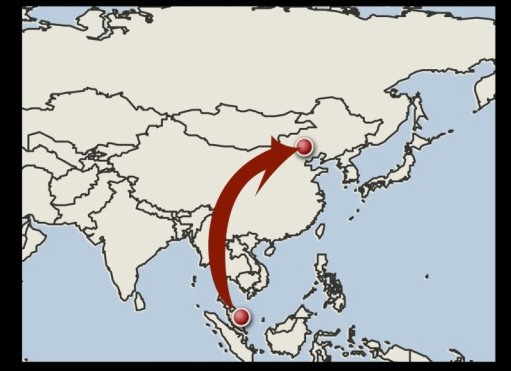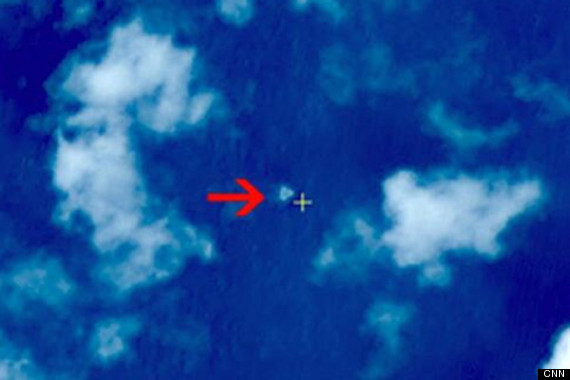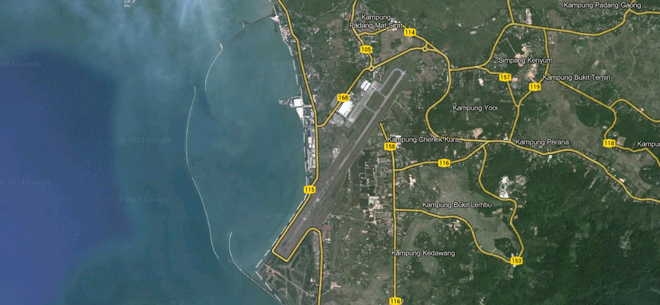updated 6:30 PM EDT, Fri March 21, 2014
(CNN) --
No struggle. No panic. No clues.
A purported transcript of the final 54 minutes
of communication withMalaysia
Airlines Flight 370 reveals nothing to
suggest a problem -- either mechanical or man-made.
Britain's The
Telegraph obtained what it reported to be
the transcript of exchanges between copilot Fariq Abdul Hamid and air
traffic controllers from before the flight took off until the final
transmission.
"MH370, please contact Ho Chi Minh
City 120.9, good night," is the last
message from Kuala Lumpur air traffic control to the flight, according
to a translated page of the document posted online by The Telegraph.
"All right, good night," was the response at 1:19 a.m. local time. That
was the last communication before the plane's transponder stopped
working.
CNN was unable to immediately verify the authenticity of the transcript.
The Telegraph reported that the Malaysian government declined to release
it.
No sign of airliner after day 2 of search in southern Indian Ocean
ccording to The Telegraph's report, nothing in the purported transcript
suggests that anything unusual or untoward occurred before
communications with the Boeing 777 ended.
It said Hamid signed in at 12:36 a.m. on the
flight fromKuala
Lumpur to Beijing. At 1:07 a.m., Hamid
says the plane was flying at a cruising altitude of 35,000 feet, which
repeated information provided six minutes earlier, The Telegraph
reported.
A former British Airways pilot who flew the same kind of aircraft found
nothing suspicious about that exchange.
"It could be as simple as the pilot forgetting or not being sure that he
had told air traffic controllers he had reached the altitude," the
former pilot, Steve Landells, told The Telegraph. "He might be
reconfirming he was at 350 (35,000 feet). It is not unusual. I wouldn't
read anything into it."
Nothing unusual appears in the purported transcript around the plane's
final transmission, which came two minutes before the transponder
halted, The Telegraph reported.
Biggest questions about Flight 370
Difficulties presented in 'remote corner of planet' may hamper Flight
370 search
By Euan
McKirdy, CNN
updated 7:37 AM EDT, Fri March 21, 2014
(CNN) --
Satellite imagery that may show debris from Malaysia
Airlines Flight 370 is
raising hopes that investigators can narrow what has been a
needle-in-a-haystack search operation.
The images, obtained and analyzed by the Australian
Geospatial-Intelligence Organisation as "a possible indication of debris
south of the search area that has been the focus of the search
operation," according to the Australian
Maritime Safety Authority, were
taken above a remote part of ocean thousands of kilometers south-east of
Australia.
Two objects, one of approximately 24 meters (78.7 ft) in length and
another around five meters (16.4 ft) long have been spotted, leading to
hopes that more information regarding the missing airliner has come to
light.
Beforehand, search corridors had extended both through central Asia and
as far south as the depths of the Indian Ocean. The new find gives cause
that the search operations can zero in on a much more focused field.
However, the area of southern Indian Ocean, 2,350 kilometers (1,460
miles) to the southeast of Perth inwestern
Australia is a remote,
potentially inhospitable area of sea which will not necessarily aid
search operations -- Australian Prime Minister Tony Abbott described the
search area Friday as the "about the most inaccessible spot you could
imagine on the face of the earth."
New Day's Chris Cuomo illustrated
the difficulty of the
task ahead. "They are saying it's the most challenging of things. It's
far, it's remote, it's very deep and you're in the storm season so it's
inclement there as well... it's a tough set of constraints," he told Richard
Quest.
The distance from Australia means that the search time of aircraft "on
station" -- within the reduced search zone -- will be limited to only a
couple of hours.
Weather will also potentially be an issue. Already, the first aircraft
on the scene which was dispatched early Thursday to assess the site, has
reported "poor visibility," despite "moderate weather conditions,"
according to the AMSA's John Young, who spoke at a media
briefingThursday. "This will hamper both air and satellite efforts,"
he said.
CNN meteorologist Pedram Javaheri says that weather in the region,
especially at this time of year, can be unpredictable. "Today marks the
first day of autumn down under, so it's not unusual to see the weather
in this part of the world start to pick up in intensity.
"We have very limited (weather) info in this remote corner of the
planet. In fact, it is so remote that (weather) satellites are even a
bit choppy that far south."
A key to the search is the height of the waves and whether there are
whitecaps present, former flight commander Rick Burgess told
CNN's Becky Anderson. "Those high waves... are very disruptive on
your search pattern when you're trying to look for objects in the
water."
He estimated that the search crews would have a window of three to four
days. "Then from there I don't see much hope in finding anything in the
near term."
The average depth in that area of the ocean is around 13,000 feet, which
is slightly less than the average depth worldwide. The area's depth
could still present significant problems for retrieving wreckage --
should the objects seen on satellite be confirmed as part of the missing
plane. There are volcanic ridges underwater which rise up from the ocean
floor, which can reduce the depth to 3,000 feet.
Also, this part of the Indian Ocean is the location of the Indian Ocean
Gyre, one of five major gyres worldwide. A gyre is an area of circular
ocean current where water does not circulate particularly freely. The
Indian Ocean Gyre is known to trap large volumes of debris in the
southern Indian Ocean as currents here are very weak and show little to
no movement over long periods of time, Javaheri said.
However, "at these very high latitudes (where the debris was spotted)...
westerly winds are typically very strong and they can certainly impact
large-scale debris and move them along," meaning that wind patterns may
have influenced the location of the sighted objects.
LIVE: Latest updates on the missing Malaysia Airlines jetliner
What can we tell from fresh lead?
If this is the debris, what happens next?
Opinion: Search for MH370 highlights need for trust, unity in Asia
Chinese satellites find large object that could be from MH370
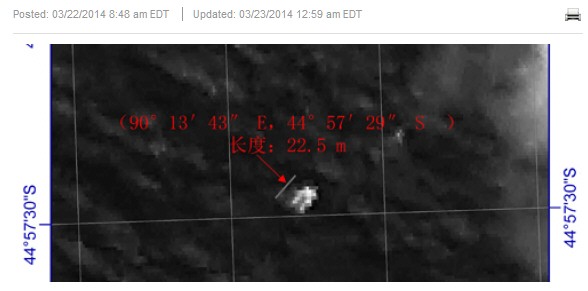
Mar 22nd 2014 7:25PM
Flight officer Rayan
Gharazeddine, on board a Royal Australian
Air Force AP-3C Orion,
scans for missing Malaysia Airlines flight MH370 in the
southern Indian Ocean on March 22, 2014. The Orion under
took a four-hour journey to search an area approximately
2,500 kms southwest of Perth, two hours on station searching
at about 400 feet above the ocean, and then a four-hour
return. China released on March 22 a new satellite image of
a large floating object possibly linked to missing Malaysia
Airlines flight MH370, boosting search efforts as anger with
the pace of the operation boiled over among Chinese
relatives in Beijing. AFP PHOTO / POOL / Rob Griffith (Photo
credit should read ROB GRIFFITH/AFP/Getty Images)
KUALA LUMPUR, Malaysia (AP) -- While possible clues about the fate of a
Malaysia Airlines jet missing for more than two weeks keep coming from
satellite images, it has been as frustrating as ever to turn the hints
from space into actual sightings.
China on Saturday released a satellite
image showing an object floating in a
remote stretch of the southern Indian Ocean near where planes and ships
have been crisscrossing since similar images from an Australian
satellite emerged earlier in the week. China's image, showing an object
that appeared to be 22 meters (72 feet) by 13 meters (43 feet), was
taken around noon Tuesday.
"The news that I just received is that the Chinese ambassador
received a satellite image of a floating object in the southern corridor
and they will be sending ships to verify," Malaysian Defense Minister
Hishammuddin Hussein told reporters.
Australian officials said the location was within the
36,000-square-kilometer (14,000-square-mile) area they searched on
Saturday, but the object was not found. Australian Maritime Safety
Authority spokeswoman Andrea Hayward-Maher said she did not know whether
the precise coordinates of the location had been searched, but added
that coordinators will use the information to refine the search area.
The authority, which is overseeing the search in the region, said a
civil aircraft reported seeing a number of small objects in the search
area, including a wooden pallet, but a New Zealand military plane
diverted to the location found only clumps of seaweed. The agency said
in a statement that searchers would keep trying to determine whether the
objects are related to the lost plane.
Despite the frustrating lack of answers, Australian Prime Minister Tony
Abbott on Sunday suggested the sightings were a positive development.
"Obviously we have now had a number of very credible leads and there is
increasing hope - no more than hope, no more than hope - that we might
be on the road to discovering what did happen to this ill-fated
aircraft," Abbott told reporters in Papua New Guinea.
The latest satellite image is another clue in
the baffling search for Malaysia
Airlines Flight 370, which dropped off
air traffic control screens March 8 over the Gulf of Thailand with 239
people on board.
After about a week of confusion, Malaysian authorities said pings sent
by the Boeing 777-200 for several hours after it disappeared indicated
that the plane ended up in one of two huge arcs: a northern corridor
stretching from Malaysia to Central Asia, or a southern corridor that
stretches toward Antarctica.
The discovery of two objects by the Australian
satellite led several countries to send planes and ships to a stretch of
the Indian
Ocean about 2,500 kilometers (1,550
miles) southwest of Australia. But three days of searching have produced
no confirmed signs of the plane.
One of the objects spotted in the earlier satellite imagery was
described as 24 meters (almost 80 feet) in length and the other was 5
meters (15 feet).
The Boeing 777-200 is about 64 meters (209 feet) long with a wingspan of
61 meters (199 feet) and a fuselage about 6.2 meters (20 feet) in
diameter, according to Boeing's website.
In a statement on its website announcing China's find, the State
Administration of Science, Technology and Industry for National Defense
did not explain why it took four days to release the information. But
there was a similar delay in the release of the Australian satellite
images because experts needed time to examine them.
Two military planes from China arrived Saturday in Perth and were
expected on Sunday to join Australian, New Zealand and U.S. aircraft in
the search. Japanese planes will arrive Sunday and ships were in the
area or on their way.
Erik van Sebille, an oceanographer at the University of New South Wales
in Sydney, said the currents in the area typically move at about one
meter (yard) per second but can sometimes move faster.
Based on the typical speed, a current could theoretically move a
floating object about 173 kilometers (107 miles) in two days.
But even if both satellites detected the same object, it may be
unrelated to the plane. One possibility is that it could have fallen off
a cargo vessel.
Warren Truss, Australia's acting prime
minister while Abbott is abroad, said before the new
satellite data was announced that a
complete search could take a long time.
"It is a very remote area, but we intend to continue the search until
we're absolutely satisfied that further searching would be futile - and
that day is not in sight," he said.
"If there's something there to be found, I'm confident that this search
effort will locate it," Truss said from the base near Perth that is
serving as a staging area for search aircraft.
Aircraft involved in the search include two ultra-long-range commercial
jets and four P3 Orions, the maritime safety authority said.
Because the search area is a four-hour flight from land, the Orions can
search for about only two hours before they must fly back. The
commercial jets can stay for five hours before heading back to the base.
Two merchant ships were in the area, and the HMAS Success, a navy supply
ship, had also joined the search.
A small flotilla of ships from China will also join the hunt, along with
a refueling vessel that will allow ships to stay in the search area for
a long time, Truss said.
Hishammuddin, the Malaysian defense minister, said conditions in the
southern corridor were challenging.
The area where the objects were identified by the Australian authorities
is marked by strong currents and rough seas, and the ocean depth varies
between 1,150 meters (3,770 feet) and 7,000 meters (23,000 feet). In
addition, Hishammuddin said a low-level warning had been declared for
Tropical Cyclone Gillian, although that was north of Australia and
closer to Indonesia.
The missing plane, which had been bound for Beijing, carried 153 Chinese
passengers. In the Chinese capital on Saturday, relatives of the
passengers rose up in anger at the end of a brief meeting with Malaysia
Airlines and Malaysian government officials.
"You can't leave here! We want to know what the reality is!" they
shouted in frustration over what they saw as officials' refusal to
answer questions. The relatives gave reporters a statement saying they
believe they have been "strung along, kept in the dark and lied to by
the Malaysian government."
Malaysian authorities have not ruled out any possible explanation for
what happened to the jet, but have said the evidence so far suggests it
was deliberately turned back across Malaysia to the Strait of Malacca,
with its communications systems disabled. They are unsure what happened
next.
Police are considering the possibilities of hijacking, sabotage,
terrorism or issues related to the mental health of the pilots or anyone
else on board.
Malaysia asked the U.S. for undersea surveillance equipment to help in
the search, said Rear Adm. John Kirby, a Pentagon spokesman. Defense
Secretary Chuck Hagel promised to assess the availability of the
technology and its usefulness in the search, Kirby said. The Pentagon
says it has spent $2.5 million to operate ships and aircraft in the
search and has budgeted another $1.5 million for the efforts.
---
Griffith reported from Perth, Australia. Associated Press writers Todd
Pitman and Eileen Ng in Kuala Lumpur, Malaysia, Kristen Gelineau in
Sydney and Didi Tang and Christopher Bodeen in Beijing contributed to
this report.
Chinese plane spots objects in Indian Ocean
Mar 24th 2014 5:14AM
P-8 Poseidon deployed by USA 2
help SAR is
one of d most sophisticated ISR Aircraft in the world.
PERTH, Australia (AP) - A Chinese plane
on Monday spotted two white, square-shaped objects in
an area identified by satellite
imagery as
containing possible debris from the missing Malaysian airliner, while
theUnited
States separately
prepared to send a specialized device that can locate black boxes.
The crew aboard an IL-76 plane sighted the
object in the southern Indian
Ocean and reported the coordinates to
the Australian command center, which is coordinating the multinational
search, as well as the Chinese icebreaker Snow Dragon, which is en route
to the area, China's Xinhua News Agency reported.
The spotters saw two larger floating objects and some smaller, white
debris scattered over several square kilometers (miles), the report
said. It gave no other details.
Satellite images released by Australia and
China had earlier identified possible debris in the area that may be
linked to the disappearance of Malaysia
Airlines Flight 370 on March 8 with 239
people aboard.
The U.S. Pacific command said it was sending a
black box locator in case a debris field is located. The Towed Pinger
Locator, which is pulled behind a vessel at slow speeds, has highly
sensitive listening capability so that if the wreck site is located, it
can hear the black box pinger down to a depth of about 20,000 feet
(6,100 meters), Cmdr. Chris Budde, a U.S. Seventh Fleet
operations officer, said in a
statement.
"This movement is simply a prudent effort to
preposition equipment and trained personnel closer to the search area so
that if debris is found we will be able to respond as quickly as
possible since the battery
life of the black box's pinger is
limited," Budde said.
The ocean depth in the search area ranges between 1,150 meters (3,770
feet) and 7,000 meters (23,000 feet).
An Australian defense official said an Australian navy support vessel,
the Ocean Shield, was also moving into the search zone and would arrive
in three or four days. The ship is equipped with acoustic detection
equipment that can search for the missing plane's black box.
There was no sign the moves was linked to any breakthrough in the
mystery of the plane, but rather as a preparation.
"The time for the battery life (of the pinger) is potentially only a
month," said Jason Middleton, aviation professor at the University of
New South Wales in Sydney. "If debris was found, it would be terrible
not have anything on site and waste time" getting a ping detector to the
region. "I think they're planning ahead and getting it ready."
The Chinese plane was one of two Ilyushins that joined the search Monday
from Perth, increasing the number of aircraft to 10 from eight a day
earlier.
The Australian Maritime Safety Authority said the objects spotted Monday
were "within today's search area and attempts will be made to relocate
them."
Bad weather was threatening the search efforts in the area, about 2,500
kilometers (1,550 miles) southwest of Perth. Australia's Bureau of
Meteorology reported increased winds, low cloud and a reduction in
visibility. On Tuesday, a cold front was expected to move through the
search area from the west, bringing showers, more low cloud and less
visibility. Tropical Cyclone Gillian, which is further to the north,
will not impact the area.
The search was given added momentum when a French satellite detected
potential debris on Sunday, after Australia and China earlier released
satellite images identifying suspect objects.
Australian authorities had sent planes and a ship to try to locate a
wooden pallet that was spotted on Saturday from a search plane, but the
spotters were unable to take photos of it.
Wooden pallets are most commonly used by ships but are also used in
airplane cargo holds, and an official with Malaysia Airlines said Sunday
night that the flight was, in fact, carrying wooden pallets. The
official spoke on condition of anonymity in keeping with company policy.
In Paris, French Foreign Ministry spokesman Romain Nadal said in an
interview with The Associated Press that the satellite radar echoes
"identified some debris that could be from the Malaysian Airlines
plane."
The spokesman said that these echoes "are not images with a definition
like a photograph, but they do allow us to identify the nature of an
object and to localize it."
Gathering satellite echo data involves sending a beam of energy to the
Earth and then analyzing it when it bounces back, according to Joseph
Bermudez Jr., chief analytics officer at AllSource Analysis, a
commercial satellite intelligence firm.
Satellite radar echoes can be converted into an image that would look
similar to a black-and-white photo, though not as clear, he said. "You'd
have to know what you're looking at," Bermudez said.
Australian Transport Minister Warren Truss said the French radar data
located the objects about 850 kilometers (520 miles) north of the
current search area, and that "we need to check that out as well."
The southern Indian Ocean is thought to be a potential area to find the
jet because Malaysian authorities have said pings sent by the Boeing
777-200 for several hours after it disappeared indicated that the plane
ended up in one of two huge arcs: a northern corridor stretching from
Malaysia to Central Asia, or a southern corridor that stretches toward
Antarctica.
Malaysian authorities have not ruled out any possible explanation for
what happened to the jet, but have said the evidence so far suggests it
was deliberately turned back across Malaysia to the Strait of Malacca,
with its communications systems disabled. They are unsure what happened
next.
Authorities are considering the possibilities of hijacking, sabotage,
terrorism or issues related to the mental health of the pilots or
someone else on board.
Malaysia's police chief, Inspector General Khalid Abu Bakar reiterated
at a news conference Monday that all the passengers had been cleared of
suspicion.
But he said that the pilots and crew were still being investigated. He
would not comment on whether investigators had recovered the files that
were deleted a month earlier from the home flight simulator of the chief
pilot.
In the U.S., Tony Blinken, President Barack Obama's deputy national
security adviser, said on CNN: "There is no prevailing theory."
"Publicly or privately, we don't know," he said. "We're chasing down
every theory."
PASSENGERS
Lives, not numbers: Snapshots of Malaysia Airlines Flight 370 passengers
By Eliott
C. McLaughlin, CNN
updated 10:47 PM EDT, Mon March 24, 2014
HERE ARE 25 PASSENGERS - WHO WERE THE
REST OF THEM?
(CNN) --
Amid the void
of information on their fates, it seems at times that the passengers
and crew of Malaysia Airlines
Flight 370 have been
reduced to a number.
Two hundred and thirty-nine.
Yet, as their families and others who love and miss them can attest
through their anguish, they are so much more. Hailing from at least a
dozen nations, they represent a vast gamut of humanity.
The youngest is 2, the oldest 76. Five passengers haven't seen their
fifth birthdays.
They are engineers, an artist and a stunt man, along with Buddhist
pilgrims, vacationers and commuters. To those who wait for them, they
are fathers, mothers, children, soulmates and the dearest of friends.
 Snapshot
of the passengers on Flight 370
Snapshot
of the passengers on Flight 370
 Family
member: Too many questions
Family
member: Too many questions
 The
anguish of waiting
The
anguish of waiting
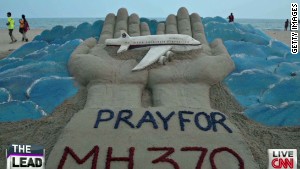 The
passengers of flight 370
The
passengers of flight 370
Days pass: No word of loved ones
As could be said of any large, random group, they are many things,
individuals with 239 unique backgrounds, idiosyncrasies and lives.
Here are a few of their stories:
Moheng Wang, Rui "Rory" Wang
and Weiwei "Vivia" Jiao
Two-year-old Moheng was the youngest passenger on the flight. He was
traveling with his parents, Rory Wang and Vivia Jiao, both in their
early 30s, back to Beijing. The family had been in Malaysia on a
vacation.
Just a week before Rory boarded the plane that would go missing, he sent
an e-mail to former classmates telling them about the vacation he was
taking before returning to Beijing to work on a project. He regularly
sends e-mails about his travel
experiences and shares
photos that he took with the latest
cameras, his MBA classmate Saleel Limaye said.
"The pictures he would send in the e-mails were just fantastic
pictures," he said.
A friend of Vivia's, Weina Shi, said the two instantly connected when
they met.
"She's just so warm, very sweet, so caring, that we just immediately
connected and became pretty good
friends," she said.
The pair would hang out and shop together as well, Shi said. Vivia was a
caring wife, the kind who leaves a note for her husband when she goes
out to run errands, she said.
Dai Shuling and Jiao Wenxue
Dai and Jiao are Vivia's parents and the grandparents of Wang Moheng.
They had joined their daughter and son-in-law in Malaysia for vacation.
Both are 58 years old.
Wen Yongsheng
Wen is a 34-year-old businessman.
His father has been one of the family members who has spoken with the
media about what the relatives are going through.
"Come back quickly. You have made everyone in the family very nervous,"
Wen's father says he would like to tell his son. "Everyone in the family
is waiting for you to return. He has to come back, everyone on board. He
can't come back by himself."
Puspanahtan Subramaniam
The 34-year-old information
technology specialist
and father was leaving his home to board Flight 370 when his two young
children clung to his legs and didn't want him to go. He had to promise
them to bring chocolates and presents when he returned from his trip
to Beijing, said his father, Gurusami Subramaniam.
"He was responsible for everything, these clothes I'm wearing, even.
Whatever country he was in, he would call. Once a week, he would come
see us with the whole family. He really took care of us."
Gurusami Subramaniam says he worked 20 years as a security guard to put
his only son through college.
Ju Kun
Ju's social media account has been flooded with well-wishers praying for
his safe return. Many know the 35-year-old martial arts expert from his
stand-ins as a stunt man in films like "The Grandmaster" and "The
Forbidden Kingdom." The latter starred genre luminaries Jackie Chan and
Jet Li. Ju was slated to begin filming on the Netflix series "Marco
Polo" in coming weeks.
Chinese actress Zhang Ziyi wrote on Weibo that Ju "is a sincere, kind
and hardworking man," while Netflix said he is "an integral part of our
production team and a tremendous talent."
Chandrika Sharma
K.S. Narendran considered going to Kuala Lampur for more information on
his wife, but ultimately, he didn't see the point. No information in
Chennai, India, is the same as no information in Kuala Lampur, so he'd
prefer to be "surrounded by family and friends."
Sharma, the executive secretary of the International Collective in
Support of Fishworkers, was en route to Mongolia for a U.N.'s Food and
Agriculture Organization conference. Narendran says he's received little
information from authorities and, like most of the world, has relied on
news reports, which "thus far amounted to nothing," he said.
Paul Weeks
Weeks left his wedding ring and watch at home when he took a mining job
in Mongolia. The New Zealander instructed his wife, Danica, to pass them
on to his two sons "should anything happen."
Danica clutched
her husband's wedding ring and
fought back tears as she explained to CNN that her husband was aboard
Malaysia Airlines Flight 370, en route to Mongolia. She describes him as
"the most amazing husband and the most amazing father," who always
spends time with his boys. She says the hardest part is the cruel
mystery: not knowing what happened to the plane.
"He had strength, character. He's just so much. He's my best friend and
my soulmate, and I just can't wait for him to come back. I hope. I
hope."
Weeks' brother Paul also called him a best friend.
"He's definitely a leader. He's a leader in the family. He has so many
friends, more than you could count. People love Paul. And in general,
he's just a wonderful man," he said.
Zaharie Ahmad Shah
Zaharie is the airline captain who was piloting the plane. He is a
central figure in the investigation. He is under scrutiny, as
investigators searched his home, but nonetheless he is among the
missing.
Malaysia's main opposition leader, Anwar Ibrahim, knows the captain and
said "he is against any form of extremism."
The captain attended political meetings and is quite passionate about
justice and democracy, Zaharie said.
Some media outlets have reported that the plane's pilot had attended the
court hearing for Ibrahim and speculated that the flight's disappearance
may have been a political act in response to the verdict.
"But he's known to be a great professional pilot, a great family man,
and I don't see him to be in any way controversial or taking any radical
stance," Ibrahim said. "And I have great difficulty in understanding why
they are casting aspersions against him purely because I'm known to
him."
Mohammed Khairul Amri Selamat
The 29-year-old Malaysian civil aviation engineer works for a private
jet charter company. Police are investigating all passengers and crew,
but he is likely to be of particular interest because of his aviation
knowledge. "I am confident that he is not involved," his father said.
"They're welcome to investigate me and my family."
Pouria Nourmohammadi and Delavar
Seyed Mohammad Reza
The two Iranians initially came under suspicion because both were
traveling on stolen passports, one Austrian and the other Italian. But
Interpol says it believes this to be a human trafficking issue.
Nourmohammadi, 18, posted on Facebook on March 4 that he was "feeling
excited," along with a picture of him standing in front of the Petronas
Towers in Kuala Lumpur. A few days earlier, he'd checked in at the
city's airport with a post saying, "For everyone that said a prayer for
me, thank you so much. I am safe and well."
Malaysian police believe Nourmohammadi was trying to emigrate to Germany
using the stolen Austrian passport. He and Reza, 29, entered Malaysia on
February 28 using valid Iranian passports, Interpol said.
Mohammed Mallaeibasir, an 18-year-old Iranian student who sent CNN
iReport a picture of himself with the two men, said he knows
Nourmohammadi from high school, having met him a few years ago in
Tehran. Nourmohammadi told him his mother lived in Frankfurt, Germany.
He'd met Reza only on the day the pair were flying from Malaysia,
Mallaeibasir said. They all went for dinner and then he dropped them off
at the airport for the flight, he said.
Gu Naijun and Li Yuan
Gu, 31, uses her Weibo account to keep her oft-traveling husband, Li,
32, apprised of the goings-on of their two "princesses," whether the
daughters are swimming, playing on the slide, dressing in frilly
costumes or just enjoying a lunch outing, The
Sydney Morning Herald reported.
The Chinese couple fell in love in Sydney and moved to its suburbs. They
had recently sold their Sylvania home and were spending most of their
time in China, the paper reported. Li, who went by Carlos, is a partner
with Beijing Landysoft Technology, where one longtime employee said he
and his coworkers were shocked. "He's a good boss, kind, and extremely
hard-working,'' the employee said.
Muktesh Mukherjee and Xiaomo Bai vacationed in Vietnam.
 A
portrait of missing passengers
A
portrait of missing passengers
 Remembering
the missing on Flight 370
Remembering
the missing on Flight 370
Muktesh Mukherjee and Xiaomo
Bai
Mukherjee, 42, is vice president of China operations for Xcoal Energy &
Resources. He and his wife, Xiaomo Bai, 37, whom broadcaster CTV
identified as Canadians who once lived in Montreal, left their two young
boys with Bai's mom in Beijing while they went on vacation in Vietnam,
according to Bai's Facebook page.
Matthew McConkey, a friend of the couple, said Mukherjee "was very much
in love with" Bai, and "as parents, nothing was more important to them
than those kids."
Mao Tugui
Hu Xianquan last spoke to her husband, Mao, a painter, March 2 as he was
boarding a plane to attend an exhibition for his work. Like Danica
Weeks, she finds the dearth of information frustrating, and her grief
has morphed to agonizing frustration.
Mohd Sofuan Ibrahim and Ch'ng
Mei Ling
Hasif Nazri, 33, was doubly sad upon learning of the plane's
disappearance. Not only did he live in the same dorm as 33-year-old
Ibrahim during their school days in Malaysia, but Mei Ling, also 33, is
another former classmate.
While Nazri acknowledges losing hope as the days drag on, he has fond
memories of his old friends. Ibrahim, who posted a Facebook photo before
boarding Malaysia Airlines Flight 370, was traveling to Beijing to begin
work for Malaysia's Ministry of International Trade and Industry. A good
student and speaker, Ibrahim is also "a good, kind-hearted friend, very
helpful, cheerful and definitely no wallflower," Nazri said.
Nazri remembers Mei Ling, meanwhile, as a funny woman with an infectious
laugh. She's a "very cheerful girl." Mei Ling works for Flexsys America
LP, an Ohio-based manufacturer of chemicals for the rubber industry, and
has lived in Pennsylvania since 2010. She "was very adaptable," Nazri
recalled from his days doing coursework with her.
Li Yuchen
Li, 27, is a Ph.D. engineering student at Britain's prestigious
Cambridge University, according
to the Cambridge News. He recently married Mingfei Ma, the report
said, but she was not traveling with him.
"Heartbreaking news this morning -- Yuchen Li (alum) was on the missing
Malaysian flight. Our thoughts are with Mingfei Ma, his friends and
family," his college is quoted as saying.
Swawand Kolekar
In Mumbai, India, Archit Joshi, 23, desperately sought information on
his classmate, Kolekar, whose family in Beijing was also desperate for
any information on his whereabouts.
Joshi described Kolekar as "very reserved but very, very intelligent ...
a bit of a techno-freak and he made a lot of circuits and projects at
engineering college."
"He didn't have many friends -- he was a bit of a loner -- but he had
all the attributes a good friend should have."
Li Yan
Li's aunt, Zhang Guizhi, traveled from central China to Beijing and was
hoping to obtain a passport to travel to wherever the plane is found.
She wasn't sure how to go about the process and began weeping when she
explained that Li, 31, had traveled with her husband and four friends to
Malaysia for vacation.
Philip Wood is an IBM executive.
Philip Wood
The 51-year-old father of two graduated from Oklahoma Christian
University in 1985 with a Bachelor of Science in math and computer
science, said school spokeswoman Risa Forrester. On
the school's Facebook page, a man wrote that Wood,
an IBM executive, is "gentle, kind, had great taste in music and was a
wonderful artist."
"His word was gold," his family said in a statement. "Incredibly
generous, creative and intelligent, Phil cared about people, his family,
and above all, Christ."
Mary and Rodney Burrows
Neighbors Mandy Watt and Don Stoke say the Burrowses are
the hard-working parents of three "successful, all happy" adult
children: two daughters and a son. Rodney Burrows had planned his trip
to China after being laid off last year, the Australian Associated Press
reported.
Watt further said of the Middle Park, Australia, couple, "I hate to use
the cliche, but they were soulmates."
Catherine and Robert Lawton
The Lawtons, a Springfield Lakes, Australia, couple, in their mid-50s,
are passionate
travelers, parents to three daughters and doting grandparents,
according to the Australian Associated Press.
Robert's brother, David, described him as a "very good father, such a
good person." Robert's sister-in-law said the Lawtons had planned their
trip with their good friends, the Burrowses. Cathy's last Facebook post
before leaving was, "Off to China."
CNN's Jessica King, Catherine E. Shoichet, Atika Shubert, Ray Sanchez,
Steven Jiang, Bharati Naik, Mariano Castillo, Laura Smith-Spark, Peter
Shadbolt, Dayu Zhang, Serena Dong, Sophie Brown, Anjali Tsui, Euan
McKirdy, Piers Morgan and Anderson Cooper contributed to this report.
Passengers
Two-thirds of the 227 passengers were Chinese citizens, including a
group of 19 artists with six family members and four staff returning
from a calligraphy exhibition of their work in Kuala Lumpur; 38
passengers were Malaysian. The remaining passengers were from 13
different countries. Of the
total, 20 were employees of Freescale
Semiconductor, a company based in Austin,
Texas – 12 were from
Malaysia and 8 from China.
Under a 2007 agreement with Malaysia Airlines, Tzu
Chi – a foreign Buddhist
organisation – immediately sent specially-trained teams to Beijing and
Malaysia to give emotional support to passengers' families. The
airline also sent its own team of caregivers and volunteers and
agreed to bear the expenses of bringing family members of the passengers
to Kuala Lumpur and providing them with accommodation, medical care, and
counselling. Altogether, 115
family members of the Chinese passengers flew to Kuala Lumpur. Some
other family members chose to remain in China, fearing they would feel
too isolated in Malaysia. The
airline offered an ex
gratia condolence
payment of US$5,000 to the family of each passenger, but
relatives considered the conditions unacceptable and asked the airline
to review them.
Crew
All the crew members were Malaysian citizens. The flight's captain was
53-year-old Zaharie Ahmad Shah of Penang;
he joined MAS in 1981 and had 18,365 hours of flying experience. Zaharie
was also an examiner qualified to conduct simulator tests for pilots.
The first
officer was 27-year-old
Fariq Abdul Hamid, an employee of MAS since 2007, with 2,763 flying
hours. Fariq was
transitioning to the Boeing 777-200 after having completed his simulator
training.
3-26-14
Malaysia plane crash: Satellite spots 122 objects in ocean that could be
plane debris
A dozen planes and five ships are searching an estimated 1.6 million
square kilometres in the Indian Ocean.
PERTH, AUSTRALIA—A
French satellite scanning the
Indian Ocean for remnants of a
missing jetliner found a possible
plane debris field containing 122 objects, a top Malaysian official
said Wednesday, calling it “the most credible lead that we have.”
Defence Minister Hishammuddin Hussein said
the objects were more than 2,500 kilometres southwest of Australia,
in the area where a desperate, multinational hunt has been going on
since other satellites detected possible jet debris.
Clouds obscured the latest
satellite images, but dozens of
objects could be seen in the gaps, ranging in length from one metre
to 23 metres. Hishammuddin said some of them “appeared to be bright,
possibly indicating solid materials.”
The images were taken Sunday and relayed by
French-based Airbus Defence and Space, a division of Europe's Airbus
Group; its businesses include the operation of satellites and
satellite communications.
Various floating objects have been
spotted by planes and satellites over
the last week, including on Wednesday, when the Australian
Maritime Safety Authority sent a
tweet saying
three more objects were seen. The
authority said two objects seen from a civil aircraft appeared to be
rope, and that a
New Zealand
military plane
spotted a blue object.
-
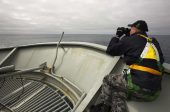 zoom
zoom
None of the objects were seen on a
second pass, a frustration that has been repeated several times in
the hunt for Malaysian
Airlines Flight
370, missing since March 8 with 239 people aboard. It remains
uncertain whether any of the objects came from the plane; they could
have come from a cargo ship or something else.
“If it is confirmed to be MH370, at least we
can then we can move on to the next phase of deep sea surveillance
search,” Hishammuddin said.
The search resumed Wednesday after fierce
winds and high waves forced crews to take a break Tuesday. A total
of 12 planes and five ships from the United States, China, Japan,
South Korea, Australia and New Zealand were participating in the
search, hoping to find even a single piece of the jet that could
offer tangible evidence of a crash and provide clues to find the
rest of the wreckage.
Malaysia announced Monday that a
mathematical analysis of the final known satellite signals from the
plane showed that it had
crashed in the sea, killing everyone on board.
The new data greatly reduced the search
zone, but it remains huge — an area estimated at 1.6 million square
kilometres, about the size of Alaska.
“We're throwing everything we have at this
search,” Australian Prime Minister Tony Abbott told Nine Network
television on Wednesday.
“This is about the most inaccessible spot
imaginable. It's thousands of kilometres from anywhere,” he later
told Seven Network television. He vowed that “we will do what we can
to solve this riddle.”
In Beijing, some
families held out a glimmer of hope their loved ones might somehow
have survived. About two-thirds of
the missing were Chinese, and their relatives have lashed out at
Malaysia for essentially declaring their family members dead without
any physical evidence of the plane's remains. Many also believe
Malaysia has not been transparent or swift in communicating
information with them about the status of the search.
Wang Chunjiang, whose brother was on the
plane, said he felt “very conflicted.”
“We want to know the truth, but we are
afraid the debris of the plane should be found,” he said while
waiting at a hotel near the Beijing airport for a meeting with
Malaysian officials. “If they find debris, then our last hope would
be dashed. We will not have even the slightest hope.”
China dispatched a special envoy to Kuala
Lumpur, Vice Foreign Minister Zhang Yesui, who met Malaysian Prime
Minister Najib Razak and other top officials Wednesday, the official
Xinhua News Agency reported.
China, which now has Chinese warships and an
icebreaker in the search zone, has been intent on supporting the
interests of the Chinese relatives of passengers, backing their
demands for detailed information on how Malaysia concluded the jet
went down in the southern Indian Ocean.
That also is the likely reason why Chinese
authorities — normally extremely wary of any spontaneous
demonstrations that could undermine social stability — permitted a
rare protest Tuesday outside the Malaysian embassy in Beijing,
during which relatives chanted slogans, threw water bottles and
briefly tussled with police who kept them separated from a swarm of
journalists.
The plane's bizarre disappearance
shortly after it took off from Kuala Lumpur en route to Beijing has
proven to be one of the
biggest mysteries in aviation.
Investigators have ruled out nothing so far
— including mechanical or electrical failure, hijacking, sabotage,
terrorism or issues related to the mental health of the pilots or
someone else on board.
The search for the wreckage and the plane's
flight data and cockpit voice recorders will be a major challenge.
It took two years to find the black box from an Air France jet that
went down in the Atlantic Ocean on a flight from Rio de Janeiro to
Paris in 2009, and searchers knew within days where the crash site
was.
There is a race against the clock to
find Flight 370's
black boxes, whose battery-powered
“pinger” could stop sending signals within two weeks. The batteries
are designed to last at least a month.
On Wednesday, the Australian Maritime Safety
Authority, which is co-ordinating the southern search operation on
Malaysia's behalf, said a U.S. Towed Pinger Locator arrived in Perth
along with Bluefin-21 underwater drone. The equipment will be fitted
to the Australian naval ship, the Ocean Shield, but AMSA could not
say when they would be deployed.
Various pieces of floating objects have been
spotted by planes and satellite, but none have been retrieved or
identified. Wednesday's search focused on an 80,000 square kilometre
swath of ocean about 2,000 kilometres southwest of Perth.
David Ferreira, an oceanographer at the
University of Reading in Britain, said little is known about the
detailed topography of the seabed in the general area where the
plane is believed to have crashed.
“We know much more about the surface of the
moon than we do about the ocean floor in that part of the Indian
Ocean,” Ferreira said.
Kerry Sieh, the director of the Earth
Observatory of Singapore, said the seafloor in the search area is
relative flat, with dips and crevices similar to that the part of
the Atlantic Ocean where the Air France wreckage was found.
He believes any large pieces of the plane
would likely stay put once they have completely sunk. But recovering
any part of the plane will be tough because of the sheer depth of
the ocean — much of it between about 3,000-4,500 metres in the
search area — and inhospitable conditions on the surface where
intense winds and high swells are common.
Australia's Bureau of Meteorology warned
that weather was expected to deteriorate again Thursday with a cold
front passing through the search area that bring rain thunderstorms,
low clouds and strong winds.
was it suicide?
The
captain of the doomed Malaysia Airlines Flight 370 was heartbroken after
separating from his wife and may have taken the plane on a "last
joyride" before crashing it into the Indian Ocean, a friend and fellow
pilot told a New Zealand newspaper.
Captain Zaharie Ahmad Shah was not in the right state of mind to fly the
Boeing 777 the day it vanished, due to the devastating breakup of his
marriage and relationship problems with a new girlfriend, said the
longtime associate who wished to remain anonymous.
He told The
New Zealand Herald that
Zaharie was "terribly upset" when his wife,
Faiza Khanum Mustafa Khan, told him she was moving out of the family
home, and the friend believed he may have decided to take the aircraft
to a part of the world he’d never flown in before and fly risky
maneuvers.
"He's one of the finest pilots around, and I'm no medical expert, but
with all that was happening in his life, Zaharie was probably in no
state of mind to be flying," said the friend.
His shocking claims came as a French satellite scanning the Indian Ocean
for remnants of a missing jetliner found a field of possible plane
debris containing 122 objects.
Malaysian Defense Minister Hishammuddin Hussein said the objects were
more than 1,550 miles southwest of Australia, in the area where a
desperate, multinational
hunthas
been going on since other satellites detected possible jet debris.
Malaysian Prime Minister Najib Razak has said that satellite data showed
the plane, carrying 239 people, crashed into the southern Indian Ocean
on March 8 eight hours after leaving Kuala Lumpur. With nowhere to land,
the jet is presumed to have crashed, killing everyone on board.
The friend told the newspaper that he’d had several conversations with
Zaharie after meeting him through work and said the pilot was a fanatic
for "the three Fs" — food, family, and flying.
He said Zaharie spent countless hours cooking and using his homemade
flight simulator while practicing conditions he could face at the helm
of a commercial airliner, such as flying at high or low altitudes. The
simulator was seized by authorities, and is being examined by the FBI.
According to reports, the aircraft made a sharp turn soon after the
co-pilot had told Malaysian air traffic controllers, "All right, good
night." Military radar has since shown that it flew as high as 45,000
feet and as low as 12,000 feet before vanishing and starting a worldwide
mystery.
The associate also told the Herald that he believed that somehow the
co-pilot, Fariq Abdul Hamid, other members of the crew, and the
passengers may have been prevented from entering the cockpit.
"It is very possible that neither the passengers nor the other crew
onboard knew what was happening until it was too late," added the
friend.
He also pointed out that the troubled captain may have taken Flight 370
on a joyride while trying high-risk maneuvers he'd perfected on his
flight simulator, according to theDaily
Mail.
Related Stories:
China ship hears `signal'; unclear if jet-related
Apr 5th 2014 2:57PM
By NICK
PERRY and EILEEN
NG
PERTH, Australia (AP) - A Chinese ship
involved in the hunt for the missing Malaysian jetliner reported
hearing a "pulse signal" Saturday in southern Indian Ocean waters
with the same frequency emitted by the plane's data recorders, as
Malaysia vowed not to give up the search for the jet.
The Australian government agency coordinating the search for the
missing plane said early Sunday that the electronic pulse signals
reportedly detected by the Chinese ship are consistent with those of
an aircraft black box. But retired Air Chief Marshal Angus Houston,
the head of the search coordination agency, said they "cannot verify
any connection" at this stage between the electronic signals and the
missing Malaysia Airlines Flight 370.
Military and civilian planes, ships with deep-sea searching
equipment and a British nuclear submarine scoured a remote patch of
the southern Indian Ocean off Australia's west coast, in an
increasingly urgent hunt for debris and the "black box" recorders
that hold vital information about Malaysia Airlines Flight 370's
last hours.
After weeks of fruitless looking, officials face the daunting
prospect that sound-emitting beacons in the flight and voice
recorders will soon fall silent as their batteries die after
sounding electronic "pings" for a month.
A Chinese ship that is part of the search effort detected a "pulse
signal" in southern Indian Ocean waters, China's official Xinhua
News Agency reported. Xinhua, however, said it had not yet been
determined whether the signal was related to the missing plane,
citing the China Maritime Search and Rescue Center.
Xinhua said a black box detector deployed by the ship, Haixun 01,
picked up a signal at 37.5 kilohertz (cycles per second), the same
frequency emitted by flight data recorders.
Malaysia's civil aviation chief, Azharuddin Abdul Rahman, confirmed
that the frequency emitted by Flight 370's black boxes were 37.5
kilohertz and said authorities were verifying the report.
Earlier Saturday, Xinhua reported that a Chinese military aircraft
searching for the missing aircraft spotted "white floating objects"
not far from where the electronic signals were detected.
Houston said the Australian-led Joint Agency Coordination Centre
heading the search operation could not yet verify the Chinese
reports and had asked China for "any further information that may be
relevant." He said the Australian air force was considering
deploying more aircraft to the area where the Chinese ship
reportedly detected the sounds.
"I have been advised that a series of sounds have been detected by a
Chinese ship in the search area. The characteristics reported are
consistent with the aircraft black box," Houston said, adding that
the Australian-led agency had also received reports of the white
objects sighted on the ocean surface about 90 kilometers (56 miles)
from where the electronic signals were detected.
"However, there is no confirmation at this stage that the signals
and the objects are related to the missing aircraft," Houston said.
Still, Malaysia's defense minister and acting transport minister,
Hishammuddin Hussein, was hopeful. "Another night of hope - praying
hard," he tweeted in response to the latest discoveries.
There are many clicks, buzzes and other sounds in the ocean from
animals, but the 37.5 kilohertz pulse was selected for underwater
locator beacons on black boxes because there is nothing else in the
sea that would naturally make that sound, said William Waldock, an
expert on search and rescue who teaches accident investigation at
Embry-Riddle Aeronautical University in Prescott, Arizona.
"They picked that (frequency) so there wouldn't be false alarms from
other things in the ocean," he said.
Honeywell Aerospace, which made the boxes in the missing Malaysia
Airlines plane, said the Underwater Acoustic Beacons on both the
flight data recorder and cockpit voice recorder operate at a
frequency of 37.5 kilohertz plus or minus 1 kilohertz.
Waldock cautioned that "it's possible it could be an aberrant
signal" from a nuclear submarine if there was one in the vicinity.
If the sounds can be verified, it would reduce the search area to
about 10 square kilometers (4 square miles), Waldock said. Unmanned
robot subs with sidescan sonar would then be sent into the water to
try to locate the wreckage, he said.
John Goglia, a former U.S. National Transportation Safety Board
member, called the report "exciting," but cautioned that "there is
an awful lot of noise in the ocean."
"One ship, one ping doesn't make a success story," he said. "It will
have to be explored. I guarantee you there are other resources being
moved into the area to see if it can be verified."
The Boeing 777 disappeared March 8 while en route from Kuala Lumpur,
Malaysia, to Beijing with 239 people aboard. So far, no trace of the
jet has been found.
Hishammuddin, the Malaysian defense minister, told reporters in
Kuala Lumpur that the cost of mounting the search was immaterial
compared to providing solace for the families of those on board by
establishing what happened.
"I can only speak for Malaysia, and Malaysia will not stop looking
for MH370," Hishammuddin said.
He said an independent investigator would be appointed to lead a
team that will try to determine what happened to Flight 370. The
team will include three groups: One will look at airworthiness,
including maintenance, structures and systems; another will examine
operations, such as flight recorders and meteorology; and a third
will consider medical and human factors.
The investigation team will include officials and experts from
several nations, including Australia - which as the nearest country
to the search zone is currently heading the hunt - China, the United
States, Britain and France, Hishammuddin said.
A multinational search team is desperately trying to find debris
floating in the water or faint sound signals from the data recorders
that could lead them to the missing plane and unravel the mystery of
its fate.
Finding floating wreckage is key to narrowing the search area, as
officials can then use data on currents to backtrack to where the
plane hit the water, and where the flight recorders may be.
Beacons in the black boxes emit "pings" so they can be more easily
found, but the batteries last for only about a month.
Officials have said the hunt for the wreckage is among the hardest
ever undertaken, and will get much harder still if the beacons fall
silent before they are found.
"Where we're at right now, four weeks since this plane disappeared,
we're much, much closer," said aviation expert Geoffrey Thomas,
editor-in-chief of AirlineRatings.com. "But frustratingly, we're
still miles away from finding it. We need to find some piece of
debris on the water; we need to pick up the ping."
If it doesn't happen, the only hope for finding the plane may be a
full survey of the Indian Ocean floor, an operation that would take
years and an enormous international operation.
Hishammuddin said there were no new satellite images or data that
can provide new leads for searchers. The focus now is fully on the
ocean search, he said.
Two ships - the Australian navy's Ocean Shield and the British HMS
Echo - carrying sophisticated equipment that can hear the recorders'
pings returned Saturday to an area investigators hope is close to
where the plane went down. They concede the area they have
identified is a best guess.
Up to 13 military and civilian planes and nine other ships took part
in the search Saturday, the Australian agency coordinating the
search said.
Because the U.S. Navy's pinger locator can pick up signals to a
depth of 6,100 meters (20,000 feet), it should be able to hear the
plane's data recorders even if they are in the deepest part of the
search zone - about 5,800 meters (19,000 feet). But that's only if
the locator gets within range of the black boxes - a tough task,
given the size of the search area and the fact that the pinger
locator must be dragged slowly through the water at just 1 to 5
knots (1 to 6 mph).
Australia's Houston acknowledged the search area was essentially a
best guess, and noted the time when the plane's locator beacons
would shut down was "getting pretty close."
The overall search area is a 217,000-square-kilometer
(84,000-square-mile) zone in the southern Indian Ocean, about 1,700
kilometers (1,100 miles) northwest of the western Australian city of
Perth.
___
Ng reported from Kuala Lumpur, Malaysia. Associated Press writers
Gillian Wong in Kuala Lumpur, Rod McGuirk in Canberra, Australia,
Kristen Gelineau and Rohan Sullivan in Sydney, and Joan Lowy in
Washington contributed to this report.
4-14-14
PERTH, Australia (AP) — Search crews will for the first time send a
robotic submarine deep into the Indian
Ocean on Monday to try
to determine whether underwater signals detected by sound-locating
equipment are from the missing Malaysian jet's black boxes, the leader
of the search effort said.
The crew on board the Australian navy's Ocean Shield will launch the
unmanned underwater vehicle Monday evening, said Angus Houston, the head
of a joint agency coordinating the search off Australia's west
coast. The Bluefin 21 autonomous sub can create a
three-dimensional sonar map of the area to chart any debris on the
seafloor.
The move comes after crews picked up a series of underwater sounds over
the past two weeks that were consistent with an aircraft's black
boxes, which contain flight data and cockpit voice recordings.
The devices have beacons that emit "pings" so they can be more easily
found, but the beacons' batteries last only about a month, and it has
been more than a month since the plane vanished.
"We haven't had a single detection in six days, so I guess it's time to
go under water," Houston said.
Australian Prime
Minister Tony Abbott
raised hopes last week when he said authorities were "very confident"
the four underwater signals that have been detected are coming from the
black boxes on Flight 370, which disappeared March 8 during a flight
from Kuala
Lumpur, Malaysia, to Beijing.
But Houston warned that while the signals are a promising lead, the
public needs to be realistic about the challenges facing search crews,
who are contending with an extremely remote, deep patch of ocean — an
area he dubbed "new to man."
"I would caution you against raising hopes that the deployment of the
autonomous underwater vehicle will result in the detection of the
aircraft wreckage. It may not," Houston said. "However, this is the best
lead we have, and it must be pursued vigorously. Again, I emphasize that
this will be a slow and painstaking process."
The Ocean Shield has been dragging a U.S. Navy device called a towed
pinger locator through the water to listen for any sounds from the black
boxes' beacons. Over the past 10 days, the equipment has picked up four
separate signals.
The Bluefin sub takes six times longer to cover the same area as the
ping locator, and the two devices can't be used at the same time. Crews
were hoping to detect additional signals before sending down the sub, so
they could triangulate the source and zero in on where exactly the black
boxes may be.
But it has been 38 days since the plane disappeared, and search crews
haven't picked up any new sounds since Tuesday, suggesting that the
devices' batteries may now be dead. That is why officials will now begin
using the Bluefin, Houston said.
The submarine will take 24 hours to complete each mission: two hours to
dive to the bottom, 16 hours to search the seafloor, two hours to return
to the surface, and four hours to download the data, Houston said. In
its first deployment, it will search a 40-square-kilometer
(15-square-mile) section of seafloor.
The black boxes could contain the key to unraveling the mystery of what
happened to Flight 370 after it disappeared with 239 people on board.
Investigators believe the plane went down in the southern Indian Ocean
based on a flight path calculated from its contacts with a satellite and
analysis of its speed and fuel capacity. But they still don't know why.
Meanwhile, officials were investigating an oil slick not far from the
area where the underwater sounds were detected, Houston said. Crews have
collected a sample of the oil and are sending it back to Australia for
analysis, a process that will take several days.
The oil does not appear to be from any of the ships in the area, but
Houston cautioned against jumping to conclusions about its source.
A visual search for debris on the ocean surface was continuing on Monday
over 47,600 square kilometers (18,400 square miles) of water about 2,200
kilometers (1,400 miles) northwest of the west coast city of Perth. A
total of 12 planes and 15 ships would join the two searches.
But Houston said that the visual search operation would be ending in the
next two to three days. Officials haven't found a single piece of debris
linked to the plane, and Houston said the chances that any would be have
"greatly diminished."
"We've got no visual objects," he said. "The only thing we have left at
this stage is the four transmissions and an oil slick in the same
vicinity, so we will investigate those to their conclusion."
Complicating matters further is the depth of the ocean in the search
area. The seafloor is about 4,500 meters (15,000 feet) below the
surface, which is the deepest the Bluefin can dive. Officials are
looking for other vehicles that could help to retrieve any wreckage,
should the Bluefin find any.
Searchers are also contending with a thick layer of silt on the bottom
that is tens of meters deep in places, which could hide debris that has
sunk.
U.S. Navy Capt. Mark Matthews said the silt may not have hidden
everything, however.
"Our experience shows that there will be some debris on top of the silt
and you should be able to see indications of a debris field," Matthews
said. "But every search is different."
A British vessel, the HMS Echo, has equipment on board that can help to
map the seafloor, which is more flat than mountainous, Houston said.
___
Associated Press writer Kristen Gelineau in Sydney, and Rod McGuirk in
Canberra, Australia, contributed to this report. Follow Margie Mason on
Twitter: twitter.com/MargieMasonAP

